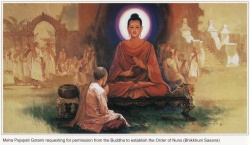Difference between revisions of "Tri-svabhāva"
| Line 1: | Line 1: | ||
[[File:Life-of-buddha-40.jpg|thumb|250px|]] | [[File:Life-of-buddha-40.jpg|thumb|250px|]] | ||
| − | '''[[Tri-Svabhāva]]''' (Skt.) The ‘three natures’—the dependent ([[Paratantra]]), the [[imagined]] ([[parikalpita]]) and the [[consummate]] ([[pariniṣpanna]]). A key [[Yogācāra]] {{Wiki|theory}} first mentioned in the [[Sandhi-nirmocana Sūtra]], the {{Wiki|concept}} of the [[three natures]] serves to explain the relationship between the [[experiences]] of [[Saṃsāra]] and [[Nirvāṇa]]. The {{Wiki|theory}} may have arisen as a means to counter [[perceived]] shortcomings in the [[Madhyamaka]] {{Wiki|theory}} of the [[Two Truths]], which seems to create an unbridgeable hiatus between [[Enlightenment]] ([[Bodhi]]) and everyday {{Wiki|experience}}. According to the [[tri-Svabhāva]] {{Wiki|theory}}, [[parikalpita]] corresponds to the [[mundane]] [[saṃvṛti-satya]] and [[pariniṣpanna]] to the {{Wiki|supramundane}} [[paramārtha-satya]], but the two are linked by [[Paratantra]], the [[conditioned]] process of {{Wiki|experience}} itself, which acts as a common pivotal factor between those two. Though the [[three natures]] {{Wiki|theory}} has sometimes been viewed as an {{Wiki|ontological}} statement, it should more properly be understood as a model of the {{Wiki|epistemological}} process—itself a major [[concern]] of the [[Yogācāra School]]. | + | |
| + | |||
| + | |||
| + | |||
| + | |||
| + | '''[[Tri-Svabhāva]]''' (Skt.) The ‘three natures’—the dependent ([[Paratantra]]), the [[imagined]] ([[parikalpita]]) and the [[consummate]] ([[pariniṣpanna]]). A key [[Yogācāra]] {{Wiki|theory}} first mentioned in the [[Sandhi-nirmocana Sūtra]], the {{Wiki|concept}} of the [[three natures]] serves to explain the | ||
| + | |||
| + | |||
| + | relationship between the [[experiences]] of [[Saṃsāra]] and [[Nirvāṇa]]. The {{Wiki|theory}} may have arisen as a means to counter [[perceived]] shortcomings in the [[Madhyamaka]] {{Wiki|theory}} of the [[Two Truths]], which seems to create an unbridgeable hiatus between [[Enlightenment]] ([[Bodhi]]) and everyday | ||
| + | |||
| + | {{Wiki|experience}}. According to the [[tri-Svabhāva]] {{Wiki|theory}}, [[parikalpita]] corresponds to the [[mundane]] [[saṃvṛti-satya]] and [[pariniṣpanna]] to the {{Wiki|supramundane}} [[paramārtha-satya]], but the two are linked by [[Paratantra]], the [[conditioned]] process of {{Wiki|experience}} itself, which acts | ||
| + | |||
| + | as a common pivotal factor between those two. Though the [[three natures]] {{Wiki|theory}} has sometimes been viewed as an {{Wiki|ontological}} statement, it should more properly be understood as a model of the {{Wiki|epistemological}} process—itself a major [[concern]] of the [[Yogācāra School]]. | ||
See also [[grāhya-grāhaka]]. | See also [[grāhya-grāhaka]]. | ||
| + | |||
| + | |||
{{R}} | {{R}} | ||
[http://www.answers.com/topic/tri-svabh-va www.answers.com] | [http://www.answers.com/topic/tri-svabh-va www.answers.com] | ||
[[Category:Buddhist Terms]] | [[Category:Buddhist Terms]] | ||
[[Category:Yogacara]] | [[Category:Yogacara]] | ||
Latest revision as of 20:42, 23 November 2020
Tri-Svabhāva (Skt.) The ‘three natures’—the dependent (Paratantra), the imagined (parikalpita) and the consummate (pariniṣpanna). A key Yogācāra theory first mentioned in the Sandhi-nirmocana Sūtra, the concept of the three natures serves to explain the
relationship between the experiences of Saṃsāra and Nirvāṇa. The theory may have arisen as a means to counter perceived shortcomings in the Madhyamaka theory of the Two Truths, which seems to create an unbridgeable hiatus between Enlightenment (Bodhi) and everyday
experience. According to the tri-Svabhāva theory, parikalpita corresponds to the mundane saṃvṛti-satya and pariniṣpanna to the supramundane paramārtha-satya, but the two are linked by Paratantra, the conditioned process of experience itself, which acts
as a common pivotal factor between those two. Though the three natures theory has sometimes been viewed as an ontological statement, it should more properly be understood as a model of the epistemological process—itself a major concern of the Yogācāra School.
See also grāhya-grāhaka.
